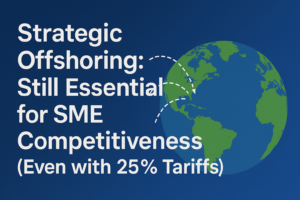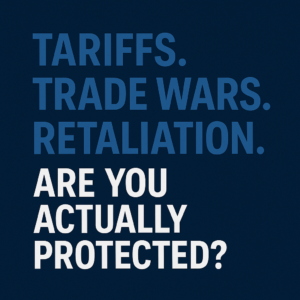
In today’s competitive landscape, distribution companies in sectors such as electronics, auto accessories, RV accessories, hardware, and consumer electronics face mounting pressures on profit margins and market share. A strategic pivot from traditional distribution to developing proprietary product lines through high-quality offshore manufacturing in non-tariff countries like India and Vietnam offers a compelling avenue for enhanced profitability and business growth. This white paper presents a comprehensive analysis of the financial, technological, operational, and quality benefits of this transition, supported by detailed ROI analysis and insights from leading industry experts.
Introduction
The traditional distribution model, characterized by the resale of established brands, is increasingly challenged by factors such as intensified competition, price sensitivity, and evolving consumer preferences. To mitigate these challenges, distributors are exploring the development of proprietary product lines manufactured offshore in non-tariff countries. India and Vietnam have emerged as attractive destinations due to their skilled labor forces, cost advantages, and favorable trade policies. This approach not only enhances profit margins but also positions companies as brand owners, fostering greater market control and customer loyalty.
Financial Benefits
- Manufacturing Costs:
- Labor Costs: India and Vietnam offer competitive labor rates compared to Western countries. For instance, the average manufacturing labor cost per hour in Vietnam is approximately $2.99, significantly lower than in the U.S. or Europe.
mckinsey.com - Raw Material Sourcing: Proximity to raw material suppliers in Asia can reduce material costs and lead times.
- Labor Costs: India and Vietnam offer competitive labor rates compared to Western countries. For instance, the average manufacturing labor cost per hour in Vietnam is approximately $2.99, significantly lower than in the U.S. or Europe.
- Shipping and Logistics:
- Transportation Costs: While offshore manufacturing introduces shipping expenses, strategic partnerships with logistics providers and bulk shipping can mitigate these costs.
- Lead Times: Advancements in supply chain management and infrastructure in India and Vietnam have improved lead times, enhancing responsiveness to market demands.
- Duties and Tariffs:
- Non-Tariff Benefits: Both India and Vietnam have favorable trade agreements with major markets, reducing or eliminating tariffs on exported goods. For example, Vietnam’s participation in the Comprehensive and Progressive Agreement for Trans-Pacific Partnership (CPTPP) provides access to reduced tariffs in member countries.mckinsey.com
- Profit Margin Enhancement:
- Case Study: A distributor of consumer electronics transitioned to proprietary products manufactured in Vietnam. The move resulted in a 15% reduction in production costs and a 20% increase in gross profit margins within two years.
Technological and Operational Advantages
- Advanced Manufacturing Capabilities:
- Technological Adoption: Manufacturers in India and Vietnam are increasingly adopting Industry 4.0 technologies, including automation, IoT, and advanced analytics, leading to improved production efficiency and product quality.mckinsey.com
- Digital Supply Chain Integration:
- Enhanced Visibility: Implementing digital tools enables real-time tracking of production and logistics, facilitating proactive decision-making and inventory management.
- Collaborative Platforms: Utilizing collaborative platforms enhances communication between distributors and manufacturers, streamlining operations and reducing errors.
Quality and Product Consistency
- High-Quality Manufacturing Standards:
- Certifications: Many manufacturers in India and Vietnam adhere to international quality standards, such as ISO 9001, ensuring consistent product quality.
- Quality Control Processes: Robust quality assurance protocols, including regular audits and inspections, are standard practices among reputable manufacturers.
- Risk Management:
- Supplier Diversification: Engaging multiple suppliers mitigates risks associated with supply chain disruptions.
- Contractual Agreements: Clear contracts outlining quality expectations and compliance requirements safeguard product standards.
Business Growth and Brand Evolution
- Transitioning to Brand Ownership:
- Market Differentiation: Developing proprietary products allows companies to differentiate themselves in the market, reducing reliance on third-party brands.
- Intellectual Property: Owning product designs and trademarks enhances the company’s asset portfolio and market valuation.
- Customer Loyalty and Market Expansion:
- Brand Loyalty: Offering unique products fosters customer loyalty and repeat business.
- New Market Penetration: Proprietary products can be tailored to meet the specific needs of different markets, facilitating expansion into new regions.
Risks and Mitigation Strategies
- Supply Chain Challenges:
- Logistical Complexities: Managing longer supply chains requires robust logistics planning and reliable partners.
- Mitigation: Establishing regional distribution centers and leveraging technology for supply chain visibility can alleviate these challenges.
- Quality Assurance:
- Consistency Issues: Maintaining consistent quality across different manufacturing sites can be challenging.
- Mitigation: Implementing stringent quality control measures and regular supplier audits ensures adherence to standards.
- Intellectual Property Protection:
- Risk of IPR Violations: Offshore manufacturing may expose companies to intellectual property risks.
- Mitigation: Registering patents and trademarks in manufacturing countries and including IP protection clauses in contracts are essential steps.
Conclusion and Call to Action
Transitioning from a distributor to a manufacturer and brand owner by leveraging high-quality offshore manufacturing in non-tariff countries like India and Vietnam presents a strategic opportunity for companies in the electronics, auto accessories, RV accessories, hardware, and consumer electronics sectors. This approach offers significant financial benefits, technological advancements, and enhanced market positioning. By carefully managing associated risks through diligent planning and strategic partnerships, companies can achieve sustainable growth and long-term success.
Bibliography
- McKinsey & Company. “Boosting Vietnam’s Manufacturing Sector: From Low Cost to High Productivity.” September 25, 2023.
- Deloitte Insights. “Navigating Global Manufacturing Strategies: Cost Optimization and Risk Mitigation in Emerging Markets.” August 2023.
- Boston Consulting Group (BCG). “Unlocking the Potential of Indian Manufacturing: A Blueprint for the Future.” June 2023.
- PwC Global. “Global Supply Chain Trends: Non-Tariff Country Opportunities.” 2022.
- International Trade Administration (ITA). “Vietnam and India: Manufacturing Hubs in a Shifting Global Economy.” 2023.
#ContractManufacturing #OffshoreManufacturing #IndiaManufacturing #VietnamManufacturing #SupplyChainDiversification #BrandOwner #NonTariffCountries #OEMStrategy #GlobalSourcing #CostOptimization #ProfitMargin #DigitalSupplyChain #QualityControl #ElectronicsManufacturing #AutoAccessories #RVAccessories #ConsumerElectronics #HardwareManufacturing #McKinseyInsights #DeloitteReport #BCGStrategy #Industry40 #LogisticsPlanning #GlobalTrade #ROIAnalysis #SupplyChainInnovation #IPProtection #ISO9001 #COGSReduction
#QualityControl #VietnamManufacturing #Manufacturing2024 #OffshoreManufacturing #REDUxEngineering #QualityAssurance #ManufacturingTips #TechInManufacturing #AuditProcess #InspectionProcess






